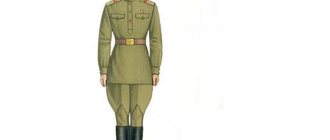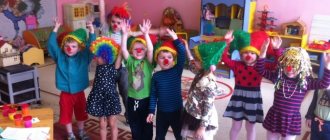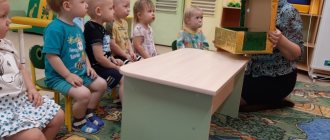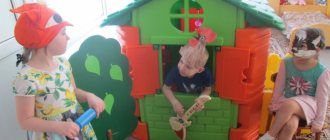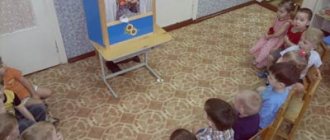The role of theatrical activities
Due to the fact that theatrical activities are based on play, it is easy for a preschooler to understand the tasks that are assigned to him. He can easily create the image of his character, give him character and live his life with him. The child develops imagination and thinks more broadly.
theatrical performance
Attention! Participation in theatrical productions allows one to identify a creative personality at a very early age, thanks to which parents can develop the child in a direction that is interesting to him, which can become the basis for successful self-realization in adulthood.
With the help of theatrical performances, children activate their vocabulary, improve the change in intonation while pronouncing lines, and practice constructing dialogues.
Dramatization of the Russian folk tale "Kolobok" using a tabletop theater
Ilyana Mamedova
Dramatization of the Russian folk tale "Kolobok" using a tabletop theater
Dramatization of a Russian folk tale
«Kolobok»
using
a tabletop theater .
Completed by: Mamedova I. I.
- activate auditory perception;
- develop the ability to act out a familiar fairy tale in a tabletop theater ;
- develop the ability to enter into a role.
Equipment: plastic cups, table theater figures for the Russian folk tale " Kolobok "
.
Introducing preschoolers to the theater
Theatrical activities in the senior group open the world of art to the kids. The teacher first introduces the concept of theater and the rules of behavior in it. The children are told about different types of theater:
- classic;
- pantomime;
- puppet;
- musical;
- finger
After which the teacher begins exercises on the strength of sound - reads quatrains at different volume levels, reinforcing what is said with gestures. During the familiarization process, children learn discipline and train to listen carefully to the speaker.
Attention! If you present your child with information about the theater as something magical and interesting, a positive association with art will be fixed in his mind, thanks to which he will be happy to independently increase his level of cultural development in adulthood.
Mitten Theater
Notes on the CHL "Table Theater "Teremok"
Olga Chizhikova
Notes on the CHL "Table Theater "Teremok"
Chizhikova Olga Sergeevna
Summary lessons on the ChHL “ Tabletop theater “ Teremok ”
Goal: to teach to listen carefully to a fairy tale, accompanying the text with a display of tabletop theater .
educational: introduce the fairy tale “ Teremok ”
, accompanying the telling of a fairy tale, showing familiar characters to children and the actions they perform using
a tabletop theater ;
developmental: continue to develop children’s speech, encouraging them to pronounce familiar phrases and answer questions; encourage children to show sympathy for animals that are left without shelter; create in children an emotionally-joyful mood from participation and interaction in a game-activity; develop the ability to solve problematic issues;
educational: to cultivate in children compassion and a caring attitude towards animals.
Material: table theater for the Russian folk tale " Teremok "
.
repeated reading of the fairy tale " Teremok "
,
watching the cartoon " Terem-Teremok "
.
Types of theatrical activities
Theatrical games in the senior group can be divided into two main types: dramatic and directorial. Children begin to master the second on their own when they play with toys: they control plush performers, speak for them, move them, and build relationships between toys.
The dramatic type of activity involves the child’s independent performance as an artist using various techniques of expressive speech.
Children as artists
Open classes
Open lessons on theatrical activities attract children with their naturalness. In the improvised auditorium sit not only familiar children and teachers, but also invited guests - parents and other teachers. The purpose of such a lesson is to demonstrate children’s involvement in art, the children’s ability to clearly and distinctly pronounce lines, and not be embarrassed by the audience.
Most often, such classes use costumes created by children together with their parents. Each child who takes part in the formation of his image becomes more closely connected with his character and is sensitive to his fate.
Research activities during a walk in the preparatory group
Attention! Sometimes it is enough to let a preschooler decorate the mask of his hero so that he feels responsible for the fate of the character.
In some preschool institutions, during music classes, children are given cards with images of characters. Having each received their role, the guys play “Turnip”, “Kolobok” or “Teremok” to the accompaniment.
Drama games
Dramatizations allow preschool children to reveal their directing abilities. One student can control several characters at once, and children are often so carried away that they involuntarily adjust the intonation of their voice individually for each character. During such performances, children learn the significance of emotions and practice their facial and intonation demonstration. The definition of character is fixed - all the heroes in the fairy tale are different, each with their own temperamental characteristics.
It is not uncommon for teachers to put on several theatrical performances each season, reinforcing the study of nature and weather patterns through play. For example, in winter, children are invited to dramatize the process of preparing various animals for wintering: some fill bins with food, insulate their homes; others gorge themselves and hibernate, while others go to warmer climes.
Toy range for director's play
Self-analysis in planning theater activities
Experienced teachers, before drawing up an art teaching project for a year or a season, conduct a survey of parents, from which they learn about the degree of emotional liberation of the children, the clarity of the child’s speech at home, the ability to use facial expressions and gestures during communication and the inclinations to empathy .
After conducting the survey, the teacher becomes clear which aspects should be paid more attention to and which ones less when compiling a card index of theatrical games in the group.
Important! Self-analysis reveals the main directions in which the selected material should be worked on and identifies weaknesses in the emotional development of children.
Text of the book “Theatrical activities in kindergarten. For classes with children 5-6 years old"
Anatoly Vasilyevich Shchetkin Theater activities in kindergarten. For classes with children 5–6 years old
From the author
I would be immensely happy if my experience in organizing theatrical activities in a preschool educational institution turned out to be useful to all those who are involved in theatrical activities with children, and to those who in the future dream of devoting themselves to art, whose name is theater.
I express my gratitude to Valentina Stepanovna Parfenova,
Honorary worker of general education of the Russian Federation, head of the children's education center "Chaika" kindergarten for the creative idea, moral and material support.
Anatoly Shchetkin
Formation of a child’s creative personality through theatrical activities
Today, when the problem of preschool education and upbringing is being widely and fundamentally solved and the tasks facing teachers of preschool educational institutions are becoming more complex, the task of introducing children to theatrical activities from a very early age remains very important.
Creative activity and the development of human creative abilities are an integral part of the socio-economic and spiritual directions of the modern social structure. The word “creativity” in the social sense means to search for, to depict something that has not been encountered in past experience, individual and social. Creative activity is an activity that gives birth to something new; the free art of creating a new product that reflects the personal “I”. Creativity is not only the creation of something new in material and spiritual culture, but also a person’s improvement of himself, primarily in the spiritual sphere.
Children's creativity is one of the pressing problems of preschool pedagogy and child psychology. It was studied by L. S. Vygotsky, A. N. Leontiev, L. I. Venger, N. A. Vetlugina, B. M. Teplov, O. M. Dyachenko, A. I. Volkov and many others.
Theatrical activity is the most common type of children's creativity. It is close and understandable to the child, lies deeply in his nature and is reflected spontaneously, because it is connected with play. The child wants to translate any of his inventions, impressions from the life around him into living images and actions. Entering the character, he plays any role, trying to imitate what he saw and what interested him, and receiving great emotional pleasure.
Theater activities help develop the child’s interests and abilities; contribute to overall development; manifestation of curiosity, desire to learn new things, assimilation of new information and new ways of action, development of associative thinking; perseverance, dedication to the manifestation of general intelligence, emotions when playing roles. In addition, theatrical activities require the child to be decisive, systematic in work, and hardworking, which contributes to the formation of strong-willed character traits. The child develops the ability to combine images, intuition, ingenuity and ingenuity, and the ability to improvise. Theatrical activities and frequent performances on stage in front of audiences contribute to the realization of the child’s creative powers and spiritual needs, emancipation and increased self-esteem. Alternating the functions of performer and spectator, which the child constantly takes on, helps him demonstrate to his comrades his position, skills, knowledge, and imagination.
Exercises for the development of speech, breathing and voice improve the child’s speech apparatus. Completing game tasks in the images of animals and characters from fairy tales helps to better master your body and understand the plastic possibilities of movements. Theatrical games and performances allow children to immerse themselves in the world of fantasy with great interest and ease, and teach them to notice and evaluate their own and others’ mistakes. Children become more relaxed and sociable; they learn to clearly formulate their thoughts and express them publicly, to feel and understand the world around them more subtly.
Organization and design of the developing subject-spatial environment of the theater studio
A kindergarten is a special institution; it is practically a second home for its employees. You always want to decorate your home, make it cozy and warm, unlike others.
The hands of educators and parents have created unique options for a developmental environment. Unfortunately, the creativity of many educators remains unclaimed. Of course, children and their parents rejoice at new finds, but the original design of the premises and invented games and toys do not always become the property of other teachers.
What is meant by the concept of a developing subject-spatial environment in a preschool institution?
Let us give the definition of the concept of Doctor of Psychological Sciences S. L. Novoselova: “A developing subject environment is a system of material objects of a child’s activity that functionally models the content of the development of his spiritual and physical appearance. An enriched environment presupposes the unity of social and natural means of ensuring a child’s varied activities. The main elements of the subject environment are architectural, landscape and natural-ecological objects, art studios, playgrounds and sports grounds and their equipment; large-sized construction kits (modules) suitable for the child’s height; themed sets of toys and aids; audiovisual and information means of education and training. The equipment of the educational process of a particular educational institution is formed in direct dependence on the content of education, age, experience and level of development of children and their activities.”
How to organize and design the subject environment of a theater studio?
Theatrical activities should provide children with the opportunity not only to study and understand the world around them with the help of fairy tales, but also to live in harmony with it, receive satisfaction from classes, various activities, and successful completion of tasks. And from this point of view, the organization of the space of the theater room is of great importance. The visual characteristics of the theater studio, that is, what children see around them in class, is an important condition for emotional education. Everything matters here: the color of the walls and ceiling, furniture, division of space into functional zones, a variety of games, toys, masks, the availability of space for children to play independently. Everything that surrounds a child largely determines his mood, forms one or another attitude towards objects, actions and even towards himself.
It is known that a child gets acquainted with the world around him with the help of vision (visual analyzer), hearing (auditory analyzer) and movements (motor analyzer). Everything that surrounds him must develop these senses and provide him with the necessary psychological comfort.
When organizing and designing the developing subject-spatial environment of a theater studio, one should rely on the following principles:
• the principle of integration and flexible zoning, indicating that the living space in the theater studio of a preschool institution should provide the opportunity to build non-overlapping spheres of activity, which will allow children, in accordance with their desires and interests, to freely engage in activities without interfering with each other;
• the principle of activity, stimulating the activity and cognitive activity of the child; the stimulating factor is the situation of free choice of the goal of action;
• the principle of freedom and independence, allowing the child to independently determine his attitude to the environment: perceive, imitate, create; independently choose what he likes;
• the principle of novelty, which allows one to overcome the stereotypicality and monotony of the environment;
• the principle of the illusion of life's truth, which allows children to be placed in conditions under which they could have the mental and actual opportunity to succumb to the created deception and believe that they are not dealing with props, but with real, genuine objects.
For successful theatrical activities, it is extremely important to have a separate room, which must be designed into a developmental environment. I was probably lucky that at the time when I began to create and design the subject-spatial environment of the theater studio, a wonderful, talented, professional graphic designer, Irina Nikolaevna Bendyukova, was working in the kindergarten. Thanks to her help, the theater studio has its current form and content.
And it all started with the idea of a playing space.
Naturally, before the first meeting with the artist, I had to see in perspective how to productively and expediently use the separate room allocated to me. How to make it fit into the space of the room:
a) stage;
b) balcony (ship), parterre;
c) cabinets for storing costumes, masks and props;
d) piano.
It was necessary to include the following sections in the plan for preparing the design of the object-spatial environment of the theater studio.
1. Design of room zones (with a detailed description of each zone):
a) stage;
b) balcony (ship), parterre;
c) cabinets for storing costumes, masks and props; place for piano;
d) windows.
2. Logistics support for decoration (with a detailed description of the required materials (wood, fabric, metal structures, etc.), indicating their quantity required for decoration).
3. Organizational issues (indicating the objects of work, deadlines and those responsible for implementation).
4. Financial work (indicating ways to finance the design of a theater studio):
a) financial resources from the accounting department of the kindergarten, funds from additional services for the development of the subject-spatial environment of the theater studio;
b) material and financial assistance from sponsors;
c) free help from parents.
After coordination and approval of the preparation plan and design sketch for the subject-spatial environment of the theater studio by the kindergarten administration, the head of the theater studio begins to implement the design plan.
I would like to wish future organizers of the design of a play space for theatrical activities to remember that there are no hopeless situations, you can always find one design option or another. We must strive to create such an atmosphere, an environment for children, so that they always play with great desire and comprehend the amazing, magical world. A world whose name is theater!
Program tasks
Theater game
Theatrical acting is a historically established social phenomenon, an independent type of activity characteristic of humans.
Tasks.
Teach children to navigate in space, to be evenly placed around the site, to build a dialogue with a partner on a given topic; develop the ability to voluntarily tense and relax individual muscle groups; remember the words of the characters in the plays; develop visual, auditory attention, memory, observation, imaginative thinking, fantasy, imagination, as well as interest in the performing arts. Practice clear pronunciation of words, practice diction. To cultivate moral and ethical qualities, a culture of behavior in the theater and in life, goodwill, contact with peers, and a love of folklore.
Rhythmoplasty
Rhythmoplasty includes complex rhythmic, musical, plastic games and exercises designed to ensure the development of natural psychomotor abilities of preschool children, their acquisition of a sense of harmony of their body with the outside world, the development of freedom and expressiveness of body movements.
Tasks.
Develop the ability to voluntarily respond to a command or musical signal, readiness to act in concert, turning on simultaneously or sequentially. Develop coordination of movements; learn to remember given poses and convey them figuratively. Develop the ability to sincerely believe in any imaginary situation. Achieve the creation of an animal image using expressive plastic movements. Cultivate humane feelings.
Culture and technique of speech
This section combines games and exercises aimed at developing breathing and freedom of the speech apparatus.
Tasks.
Develop speech breathing and correct articulation, clear diction, varied intonation, speech logic; develop coherent figurative speech, creative imagination, the ability to compose short stories and fairy tales, and select simple rhymes. Learn to pronounce tongue twisters and poems, practice clear pronunciation of consonants at the end of a word. Learn to use intonations that express basic feelings. Replenish your child's vocabulary.
Fundamentals of theatrical culture
This section is intended to provide conditions for preschoolers to acquire basic knowledge and concepts, and professional terminology of theatrical art. The section includes the following main topics: features of theatrical art; types of theatrical art, the basics of acting. Spectator culture.
Tasks.
Introduce children to theatrical terminology; with the main types of theatrical art; cultivate a culture of behavior in the theater.
Work on the play
Work on the performance is based on the author's plays and includes familiarization with the play, fairy tale, as well as work on the performance - from sketches to the birth of the performance.
Tasks.
Learn to compose sketches based on fairy tales and fables; develop skills in working with imaginary objects; learn to find key words in individual phrases and sentences and highlight them with your voice; develop the ability to use intonations that express various emotional states (sad, happy, angry, surprising, admiring, pitiful, contemptuous, condemning, mysterious, etc.); replenish vocabulary, figurative speech.
Common Programming Tasks
• Form and activate children's cognitive interest.
• Relieve tightness and stiffness.
• Develop visual and auditory attention, memory, observation, resourcefulness, fantasy, imagination, imaginative thinking.
• Develop an ear for music.
• Develop the ability to coordinate your actions with other children.
• Develop the ability to communicate with people in different situations.
• Develop an interest in performing arts.
• Develop the ability to believe in any imaginary situation (transform and transform).
• Develop skills in working with imaginary objects.
• Learn to write sketches based on fairy tales.
• Learn to improvise dramatization games based on familiar fairy tales.
• Develop a sense of rhythm and coordination of movements.
• Develop plastic expressiveness and musicality.
• Develop motor abilities, dexterity, mobility.
• Learn to create images of living beings using expressive plastic movements.
• Develop the ability to use a variety of gestures.
• Develop speech breathing and correct articulation.
• Develop diction by reading tongue twisters and poetry.
• Train clear pronunciation of consonants at the end of a word.
• Expand your vocabulary.
• Learn to build a dialogue.
• Learn to use intonations that express basic feelings.
• To introduce theatrical terminology and types of theatrical art.
• Introduce the creators of the play.
• Familiarize yourself with the structure of the auditorium and stage.
• Foster a culture of behavior in the theater.
Expected skills of children
• Able to act in a coordinated manner, engaging in action simultaneously or sequentially.
• Able to relieve tension from individual muscle groups.
• Remember given poses.
• Remember and describe the appearance of any child.
• Know 5–8 articulation exercises.
• They know how to exhale long while taking an imperceptible short breath, do not interrupt their breathing in the middle of a phrase and soundlessly.
• They can pronounce tongue twisters at different rates, in a whisper.
• They can pronounce the same phrase or tongue twister with different intonations.
• They are able to expressively read a dialogical poetic text, pronouncing words correctly and clearly with the necessary intonations.
• Able to form sentences with given words.
• They know how to write sketches based on fairy tales.
• Able to build a simple dialogue.
Class notes
Lesson 1. Game program “While the curtain is closed”
Target.
To develop children's interest in performing arts. Cultivate goodwill and sociability in relationships with peers. Improve attention, memory, observation skills.
Progress of the lesson
1. Introductory conversation.
2. Game program.
The hall is festively decorated with flags, balloons, and music is playing - songs from cartoons. The teacher leads the children around the hall and places them in a creative semicircle. After the greeting, he says: “Why is the hall so beautiful today? (Because today is a holiday!)
Right! Today is a holiday - the beginning of the work of the theater studio. And we should spend this holiday very fun, since it’s always interesting to play.”
The game “Me too!” is played. The teacher says what he is doing, and the children respond loudly at a signal: “Me too!”: In the morning I get up... (And me too!)
I wash my face... I brush my teeth... I put on clean clothes... I have breakfast... I go outside... I sit in a dirty puddle..."
Educator Who is our little pig who likes to roll in puddles? One can only feel sorry for his mother. Let's try again! I love watching the play. (Me too!) Me
I don’t talk in the hall... I’m the neatest... I walk on the street... I offend all the guys...
Educator: Who is so brave here - he offends the children? It's not good to offend guys! But I think that now no one will make a mistake. I love happy music... (Me too!) Me
I dance with my friends...
(Me too!)
Now show me how you can dance.
Music is playing. Children are dancing.
Then a game is played to test the knowledge of theatrical terminology.
Pedagogist: What is the name of the building where the actors perform the play? (Theater.)
What is the name of the fabric that separates the stage from the auditorium?
(Curtain.)
What are the names of the things, genuine or fake, that are necessary during the course of the performance?
(Props.)
Who gives out the roles, directs the actors and the production of the play?
(Director.)
What is the position of the actors on stage at a certain moment called?
(Mise-en-scene.)
Today we remembered the words “theater”, “curtain”, “props”, “director”, “mise-en-scene”. Let's repeat them again.
Game “Birds, go to their nests!”
Children stand in a circle; they are “birds”. The driver (teacher) is in the middle of the circle. He walks past the players and, turning to one of the guys, says: “The bird is flying away!” The child to whom he said these words follows the driver. This is how a whole string of “birds” is formed. The driver performs various movements while walking, and the “birds” repeat them after him. Suddenly the driver shouts: “Birds, go to their nests!” and quickly takes someone's place in the circle. The remaining players take any available seats. The one who is late becomes the driver.
The game is played with musical accompaniment: the “birds” follow the leading dance step, and the children standing still clap and stamp their feet.
Lesson 2. Listen to the fairy tale, my friend, and play it
Target.
Develop speech breathing, correct articulation, diction. Improve memory, attention, imagination, communication of children.
Progress of the lesson
1. Exercises “Soap Bubbles”, “Jolly Piglet”.
2. Tongue twister “Six little mice are rustling in the reeds.”
3. Fairy tale “The Bunny and the Hedgehog”.
The lesson begins with breathing exercises “Soap Bubbles” and “Jolly Piglet”.
Then the teacher slowly pronounces a tongue twister: “Six little mice are rustling in the reeds.” The children repeat it. In this case, you need to monitor the precise articulation of the letter w.
Gradually the pace increases.
Fairy tale "The Bunny and the Hedgehog".
Educator: Why don’t we watch some interesting fairy tale now? Are you ready to create a fairy tale together? (Ready.)
Let's begin! The sun shines brightly.
The teacher invites the performer to play the role of the Sun. The sun begins to “shine brightly” with all its might - it spreads its arms to the sides, puffs out its cheeks, opens its eyes wide, and spins in place.
P e g a g o g. Suddenly the wind blew.
Two or three children play the role of the Wind - they run out and blow hard on the Sun.
Pedagogist: A small cloud ran into the sun.
A girl runs out and blocks the Sun.
Pedagogical The wind blew stronger, and leaves began to fly off the trees. (Children pretend to be trees.)
A bunny ran up to the tree.
(The Bunny appears.)
He stood on his hind legs and cheerfully waved his ears.
A hedgehog approached the bunny. There was a nice apple sitting on its thorns. (The Hedgehog comes out, holding a fake apple in his hands.)
The Hedgehog treated the bunny.
At this time the first snow fell on the ground. (Snowflake girls perform a dance.)
Cheerful snowflakes swirled in the air and landed on the ground.
Soon the snow covered the hare and the hedgehog. (The Snowflake Girls close a circle around the Hare and the Hedgehog.)
But then the sun came out again.
(Tuchka Girl runs away from the Sun).
It shone brightly, brightly.
(The sun “directs its rays” to the Snowflakes.)
And the snowflakes melted. And the friends, freed from the snow, shook themselves off, rejoiced at the sun, jumped up and ran each their own way.
The Hare and the Hedgehog leave to the music, waving their paws to the guys goodbye.
P a g o g Guys, we acted out a fairy tale. The heroes of the fairy tale did not say a word, they performed everything in silence. Such a game on stage is called pantomime - it is a game without words, in which only gestures, facial expressions and body movements are used. We will play this fairy tale again in the next lesson.
Theater project in the senior group
Play theater should be a constant presence in children's lives. To do this, teachers keep notes on theater activities, where they distribute various types of performances, evenly distributed throughout the academic year.
The results of the lessons in the garden are:
- communicative development of children of different ages;
- familiarization with the history of the origin of the theater and its purpose;
- joint creation of props and stage images;
- increasing parents' attention to the creative activities of preschoolers;
- creating a screen for further use by children in independent theatrical performances.
Making your own actors
The theater design should reflect the needs of children's development in accordance with their age characteristics. Often, children need to give free rein to their imagination to organize their own theatrical performance. So, children 4-5 years old can quite successfully put on a show using only spoons. A healthy imagination is enough to mentally endow each spoon with appearance, character, and create a fictional image. Even at the stage of self-analysis, teachers find out the pupils’ ability to think outside the box, leaving the child, as if by accident, alone at the table with two or three spoons. Some children begin to get bored over time and look in the direction of their frolicking peers, while others, already in the first minute, take up spoons and begin to play with them like dolls.
Drawing lessons by design for middle and senior kindergarten groups
Additional Information! Children who are unable to create instruments for play from everyday objects using their imagination especially need theater, which will allow them to develop non-standard thinking and relieve them of emotional constraint.
Card index of theatrical games
According to the Federal State Educational Standard, each group must have a card index of theatrical games, selected in accordance with the interests of the children, their emotional needs and characteristics.
Popular games included in the card index for the senior group of preschool educational institutions:
- Finger Theater "The Fox and the Hare". The production involves 6 children - 5 characters and one who is responsible for the words of the author. Children wear characters on their fingers, who take turns appearing on stage.
- Classic production "Granddaughter Snow Maiden". The whole group can participate - 5 main characters and secondary roles assigned to the Snow Maiden’s many girlfriends.
- The director's work "Emelya", in which one child can participate, controlling all the characters at once, or several children sharing all the roles among themselves. The production should include a model of a furnace and an ice hole, in the creation of which the entire group took part.
- A dramatization of the fairy tale “Fear has big eyes.” The production involves 6 children, including the author reading the words.
- Mitten theatricalization of the fairy tale “The Fox and the Jug.” 3 children participate in the production; hands and intonation are actively involved.
Additional Information! Before starting to prepare theatrical presentations and performances, children need to be familiarized with the work. Answer all their questions that arise along the way. Explain the idea of the work and its moral. Once the children understand the meaning of the fairy tale, they will be happy to try to play it.
Classes in preschool institutions are organized by professionals, teachers with experience and professional education. At home, arranging such a useful activity will not be difficult if you direct ordinary children's play in the right direction. To do this, you need to spend a little effort on creating a theater corner in which each fairy tale will be shown. And noisy, aimless children's play will instantly turn into priceless creative development.
